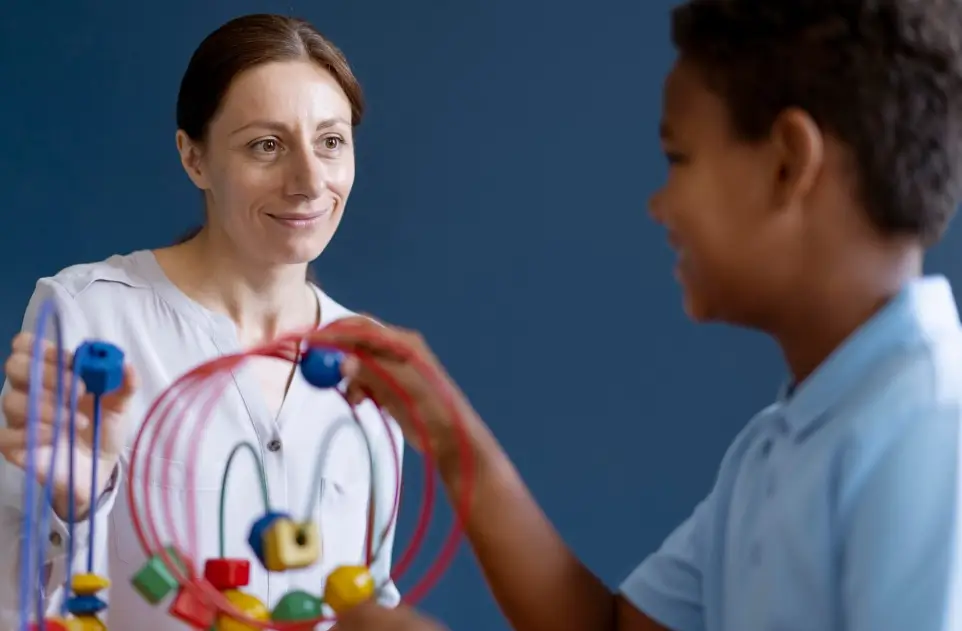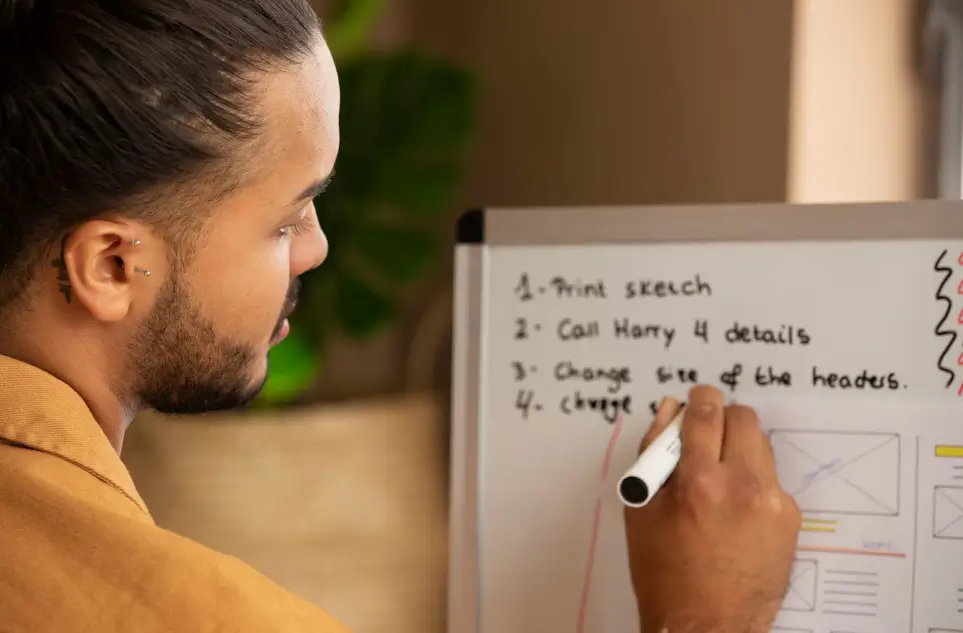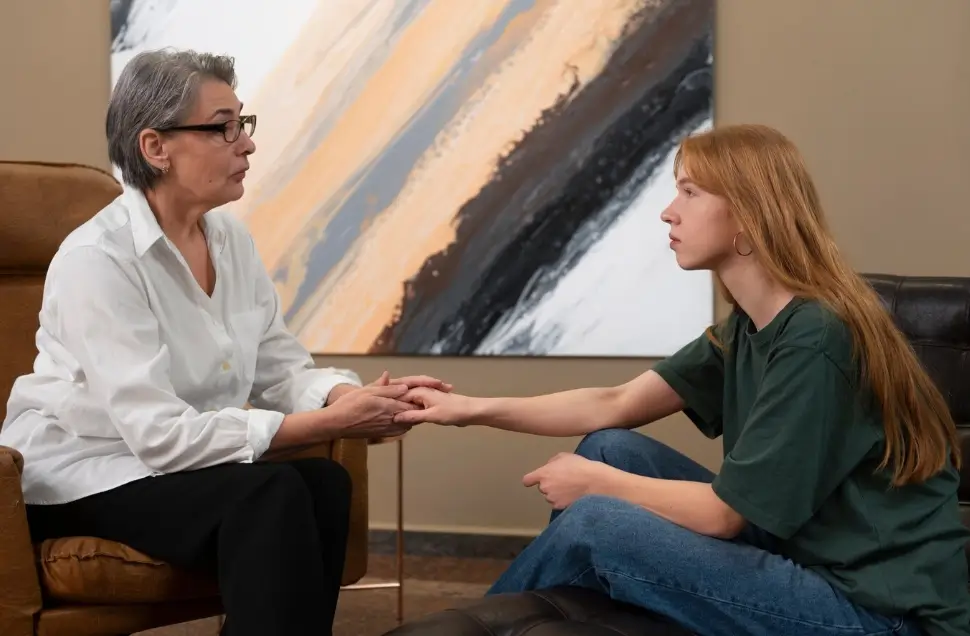Cognitive Behavioral Therapy (CBT)
CBT connects thoughts, feelings, and behaviors to help you break free from negative patterns. This evidence-based approach gives you practical tools to identify and change the thought processes that contribute to depression, anxiety, and other mental health challenges.

How CBT Works
CBT operates on the principle that our thoughts directly influence our emotions and actions. When you think negatively about yourself or situations, you feel worse and behave in ways that reinforce those negative thoughts. This creates a cycle that keeps you stuck.
During CBT sessions, you’ll learn to recognize automatic thoughts that pop up throughout your day. These thoughts often happen so quickly that you don’t notice them, but they still affect how you feel and act. Your therapist will help you slow down and examine these thoughts.
You’ll also learn to question the accuracy of negative thoughts. Are they based on facts or assumptions? Are you jumping to conclusions? Are you catastrophizing? CBT teaches you to gather evidence for and against your thoughts, helping you develop more balanced perspectives.
What Happens in CBT Sessions
Each session follows a structured format. You’ll start by reviewing homework from the previous week, then focus on current problems or challenges. Your therapist will help you identify the thoughts and behaviors connected to these problems.
You’ll learn specific techniques during sessions, then practice them between appointments. This might include keeping thought records, trying behavioral experiments, or scheduling pleasant activities. The homework component is crucial because real change happens when you apply CBT skills to your daily life.
Sessions typically last 45-50 minutes and occur weekly. Most people need 12-20 sessions to see significant improvement, though some notice changes within the first few weeks.


CBT Techniques You'll Learn
Cognitive Restructuring helps you identify and challenge distorted thinking patterns. You’ll learn to recognize common thinking errors like all-or-nothing thinking, mental filtering, and fortune telling. Once you spot these patterns, you can develop more realistic and helpful thoughts.
Behavioral Activation involves scheduling activities that give you a sense of accomplishment or pleasure. This technique is particularly helpful for depression, as it helps break the cycle of inactivity and low mood.
Exposure Therapy gradually exposes you to feared situations or objects in a controlled way. This helps reduce anxiety and avoidance behaviors by showing you that feared outcomes rarely happen or are less catastrophic than expected.
Problem-Solving Training teaches you to break down overwhelming problems into manageable steps. You’ll learn to generate multiple solutions, evaluate their pros and cons, and implement the best option.
Conditions CBT Treats
CBT effectively treats depression, including major depressive disorder and persistent depressive disorder. It helps you identify and change negative thought patterns that fuel depressive symptoms.
For anxiety disorders, CBT teaches you to examine anxious thoughts and gradually face feared situations. This includes generalized anxiety disorder, social anxiety, panic disorder, and specific phobias.
CBT also helps with obsessive-compulsive disorder by teaching you to resist compulsions and tolerate the anxiety that comes with not performing them. Over time, this reduces both obsessions and compulsions.
Post-traumatic stress disorder responds well to CBT, particularly trauma-focused CBT that helps you process traumatic memories and reduce avoidance behaviors.


What Makes CBT Effective
CBT focuses on present problems rather than spending extensive time analyzing your past. While your history is important, CBT emphasizes learning skills you can use right now to feel better.
The approach is goal-oriented and time-limited. You’ll work with your therapist to set specific, measurable goals and track your progress toward achieving them. This structure helps you see concrete improvements.
CBT gives you tools you can use long after therapy ends. The skills you learn become part of your toolkit for managing future challenges. Many people find they can prevent relapses by continuing to use CBT techniques on their own.
Getting Started with CBT
CBT works best when you’re ready to actively participate in your treatment. This means completing homework assignments, practicing skills between sessions, and being open to examining your thoughts and behaviors.
You don’t need to have all the answers or be motivated all the time. Your therapist will help you work through ambivalence and build motivation. However, CBT does require some level of engagement and willingness to try new approaches.
Break free from negative thoughts; Get help today

Dialectical Behavior Therapy (DBT)
DBT helps you manage intense emotions and improve relationships through a combination of acceptance and change strategies. Originally developed for people with borderline personality disorder, DBT now treats anyone who struggles with emotional regulation, self-harm, or interpersonal difficulties.
The DBT Approach
DBT recognizes that some people are more emotionally sensitive than others. If you’re highly sensitive, you feel emotions more intensely, react more quickly, and take longer to return to baseline. This isn’t a character flaw—it’s how your nervous system works.
The therapy teaches you that you can accept yourself as you are while still working to change problematic behaviors. This balance between acceptance and change is called dialectical thinking, and it’s central to DBT.
DBT combines individual therapy with skills training groups. Individual sessions focus on your specific challenges and help you apply DBT skills to your life. Group sessions teach concrete skills through instruction, practice, and homework.
The Four DBT Modules
Mindfulness forms the foundation of all other DBT skills. You’ll learn to observe your thoughts, emotions, and sensations without judgment. Mindfulness helps you stay present instead of getting caught up in regrets about the past or worries about the future.
The module teaches you to participate fully in activities, focus on one thing at a time, and act with awareness rather than on autopilot. You’ll practice these skills through meditation, mindful breathing, and everyday activities like eating or walking.
Distress Tolerance gives you tools to survive crisis situations without making them worse. When you’re extremely upset, your first instinct might be to do something that provides immediate relief but creates long-term problems.
This module teaches you to tolerate distress without turning to destructive behaviors. You’ll learn distraction techniques, self-soothing strategies, and ways to improve difficult moments without making them worse.
Emotion Regulation helps you understand and manage your emotions more effectively. You’ll learn to identify emotions, understand what triggers them, and reduce your vulnerability to emotional overwhelm.
The module teaches you how to change unwanted emotions and how to experience emotions without being controlled by them. You’ll also learn opposite action—acting opposite to what your emotion is telling you to do when the emotion isn’t justified or helpful.
Interpersonal Effectiveness focuses on getting your needs met while maintaining relationships and self-respect. Many people struggle with being either too passive or too aggressive in relationships.
This module teaches you to ask for what you need, say no to unreasonable requests, and handle conflict effectively. You’ll learn specific communication skills and strategies for different types of relationships and situations.
DBT Skills in Action
TIPP is a distress tolerance skill for crisis situations. When you’re extremely upset, you can change your body temperature with cold water, do intense exercise, practice paced breathing, or use paired muscle relaxation. These techniques quickly reduce emotional intensity.
PLEASE is an emotion regulation skill that helps you stay emotionally balanced. Treat physical illness, balance eating, avoid mood-altering substances, balance sleep, and get exercise. Taking care of your body makes you less vulnerable to emotional problems.
DEAR MAN is an interpersonal effectiveness skill for making requests or setting boundaries. Describe the situation, express your feelings, assert your needs, reinforce the benefits, stay mindful, appear confident, and be willing to negotiate.
Who Benefits from DBT
DBT helps people with borderline personality disorder learn to manage intense emotions and improve relationships. The therapy significantly reduces self-harm behaviors, suicidal thoughts, and hospitalizations.
People with eating disorders benefit from DBT’s focus on emotion regulation and distress tolerance. The skills help you tolerate difficult emotions without turning to disordered eating behaviors.
DBT also helps with substance use disorders, chronic depression, and post-traumatic stress disorder. Anyone who struggles with emotional intensity, impulsivity, or relationship difficulties can benefit from DBT skills.
The DBT Commitment
DBT requires a significant commitment. You’ll attend weekly individual sessions and weekly group sessions. This typically continues for one year, though some people need longer.
You’ll also need to complete homework assignments and practice skills between sessions. DBT isn’t just about learning concepts—it’s about building new habits and ways of responding to difficult situations.
The therapy includes phone coaching, which means you can contact your therapist between sessions when you’re having trouble using skills. This support helps you apply DBT techniques when you need them most.
Learn emotional regulation skills; Call us today

Acceptance & Commitment Therapy (ACT)
ACT helps you develop psychological flexibility—the ability to stay present with difficult thoughts and feelings while taking action toward what matters most to you. Instead of fighting against internal experiences, you learn to have them without being controlled by them.

The ACT Philosophy
ACT recognizes that trying to eliminate difficult thoughts and feelings often backfires. The more you try to avoid anxiety, sadness, or painful memories, the more they tend to show up. This creates a cycle where you spend enormous energy fighting your internal experiences instead of living your life.
The therapy teaches you that thoughts and feelings are normal parts of human experience. You don’t need to feel good all the time to live a meaningful life. In fact, pursuing meaningful goals often involves discomfort, challenge, and uncertainty.
ACT helps you develop a different relationship with your thoughts and feelings. You learn to see them as temporary experiences rather than permanent truths about yourself or your situation. This shift allows you to respond more flexibly to life’s challenges.
Core ACT Processes
Acceptance means allowing difficult thoughts and feelings to exist without trying to change, avoid, or control them. This doesn’t mean you like them or want them—it means you stop wasting energy fighting them.
You’ll learn that acceptance is an active choice, not passive resignation. When you accept difficult experiences, you free up energy to focus on what you can control—your actions.
Cognitive Defusion helps you see thoughts as mental events rather than absolute truths. You’ll learn techniques to step back from thoughts and observe them without getting caught up in their content.
For example, instead of thinking “I’m a failure,” you might notice “I’m having the thought that I’m a failure.” This small shift creates space between you and your thoughts, reducing their impact on your behavior.
Values Clarification involves identifying what matters most to you across different life domains. Values are different from goals—they’re ongoing directions rather than destinations you reach.
You might value being a caring parent, contributing to your community, or developing your creativity. Values give your life meaning and direction, even when you’re struggling with difficult emotions.
Committed Action means taking steps toward your values, even when you don’t feel motivated or when obstacles arise. You’ll learn to set goals that align with your values and take action despite difficult thoughts and feelings.
ACT Techniques
The Passengers on the Bus metaphor helps you understand your relationship with difficult thoughts and feelings. You’re the driver of your life’s bus, and thoughts and feelings are passengers. The passengers might be loud or demanding, but you don’t have to let them control where you go.
Leaves on a Stream is a mindfulness exercise where you imagine placing thoughts on leaves floating down a stream. This helps you practice observing thoughts without getting caught up in their content.
Values Card Sort helps you identify your core values by sorting cards representing different life domains and rating their importance to you. This exercise clarifies what you want your life to stand for.
Behavioral Experiments involve trying new behaviors aligned with your values, even when you feel anxious or unmotivated. These experiments help you learn that you can take meaningful action regardless of how you feel.
Conditions ACT Treats
ACT effectively treats anxiety disorders by helping you accept anxious thoughts and feelings while taking action toward what matters to you. Instead of trying to eliminate anxiety, you learn to have it while still engaging in meaningful activities.
For depression, ACT helps you identify values and take small steps toward them, even when you feel unmotivated or hopeless. This behavioral activation approach often improves mood as a byproduct of meaningful activity.
ACT also helps with chronic pain by teaching you to accept pain while engaging in valued activities. You learn that pain doesn’t have to stop you from living according to your values.
The therapy treats workplace stress, relationship difficulties, and life transitions by helping you clarify what matters most and take action toward those priorities.
Living with Psychological Flexibility
Psychological flexibility means you can adapt your behavior to different situations and long-term goals. When you’re psychologically flexible, you can experience difficult emotions without being overwhelmed by them.
You become more resilient because you’re not constantly fighting against your internal experiences. Instead, you use your energy to pursue meaningful goals and build the life you want.
ACT helps you develop this flexibility through practice and experimentation. You’ll try new ways of relating to thoughts and feelings, and you’ll take action toward your values even when it’s difficult.
Getting Started with ACT
ACT works best when you’re willing to try a different approach to managing difficult thoughts and feelings. You don’t need to believe in the concepts initially—you just need to be willing to experiment.
The therapy involves exercises, metaphors, and behavioral experiments. You’ll spend time identifying your values, practicing mindfulness, and taking committed action toward what matters to you.
Live according to your values; Learn more
Rogerian Therapy (Person-Centered Therapy)
Person-centered therapy creates a safe, non-judgmental space where you can explore your thoughts and feelings at your own pace. This approach trusts your innate capacity for growth and self-understanding, allowing you to lead the therapeutic process.
The Person-Centered Approach
Person-centered therapy believes that you are the expert on your own experience. Rather than diagnosing problems or prescribing solutions, your therapist provides the conditions necessary for you to discover your own answers.
The approach assumes that people naturally move toward growth and self-actualization when given the right environment. Problems arise when this natural tendency is blocked by conditions that make you feel you must be someone other than who you are.
Your therapist won’t give advice, interpret your behavior, or direct the conversation. Instead, they’ll follow your lead and help you explore whatever feels most important to you in each session.
Core Therapeutic Conditions
Unconditional Positive Regard means your therapist accepts you completely, without conditions or judgments. This doesn’t mean they approve of everything you do, but they maintain a fundamental respect for you as a person.
This acceptance creates safety to explore parts of yourself you might usually hide or deny. When you don’t have to worry about being judged, you can be more honest about your thoughts, feelings, and experiences.
Empathy involves your therapist understanding your emotional experience from your perspective. They’ll reflect back what they hear and sense, helping you feel truly understood.
This empathic understanding helps you feel less alone with your struggles. It also helps you develop greater self-awareness as you hear your experiences reflected back to you.
Genuineness means your therapist is authentic and real in their interactions with you. They don’t hide behind a professional facade or pretend to be someone they’re not.
This authenticity helps build trust and creates a genuine human connection. When your therapist is real with you, it gives you permission to be real as well.
The Therapeutic Process
Person-centered therapy doesn’t follow a predetermined structure or agenda. Each session evolves based on what you bring and what feels most important to explore.
You might spend time talking about current stressors, childhood experiences, relationship patterns, or life goals. Your therapist will follow your lead and help you explore whatever emerges.
The process often involves periods of confusion, insight, and emotional release. Your therapist will stay present with you through all of these experiences, providing support without trying to rush or direct the process.
What Makes Person-Centered Therapy Different
Unlike other therapies that focus on symptoms or specific problems, person-centered therapy focuses on you as a whole person. It recognizes that you’re more than your problems or diagnoses.
The approach doesn’t pathologize your experiences or try to fit you into diagnostic categories. Instead, it sees your struggles as understandable responses to life circumstances and unmet needs.
Person-centered therapy also emphasizes the therapeutic relationship itself as the primary agent of change. The healing happens through the experience of being truly seen, heard, and accepted.
Benefits of Person-Centered Therapy
Increased Self-Awareness develops as you explore your thoughts and feelings in a safe environment. You’ll gain greater understanding of your patterns, needs, and motivations.
Improved Self-Acceptance grows as you experience unconditional positive regard from your therapist. This helps you develop a more compassionate relationship with yourself.
Better Emotional Expression emerges as you feel safe to share your true feelings. Many people discover they’ve been suppressing emotions or don’t know how to express them effectively.
Greater Authenticity develops as you feel permission to be yourself. You’ll become more comfortable with who you are rather than who you think you should be.
Improved Relationships often result from increased self-awareness and authenticity. As you become more genuine with yourself, you can be more genuine with others.
Who Benefits from Person-Centered Therapy
People who feel misunderstood or judged often benefit greatly from person-centered therapy. The unconditional acceptance can be profoundly healing for those who’ve experienced criticism or rejection.
Individuals struggling with self-esteem issues find the approach helpful because it provides a corrective experience of being valued and accepted. This can help you develop a more positive relationship with yourself.
People going through major life transitions appreciate the space to explore their feelings and discover their own direction. The approach doesn’t pressure you to make decisions before you’re ready.
Those who’ve had negative experiences with other types of therapy may find person-centered therapy more comfortable because it doesn’t involve interpretation, diagnosis, or homework assignments.
The Role of the Therapeutic Relationship
In person-centered therapy, the relationship between you and your therapist is the primary tool for healing. Through experiencing genuine acceptance, empathy, and authenticity, you internalize these qualities.
This relationship provides a model for how relationships can be. Many people haven’t experienced being truly listened to or accepted unconditionally. The therapeutic relationship shows you what this feels like.
Over time, you may begin to treat yourself with the same kindness and acceptance your therapist shows you. This internal shift often leads to improved relationships with others as well.
Explore your inner world; Book a session

Coaching
Coaching focuses on helping you achieve specific goals and create positive changes in your life. Unlike therapy, which often addresses past issues and emotional healing, coaching concentrates on present challenges and future possibilities.

Coaching vs. Therapy
Coaching assumes you’re basically healthy and functional but want to optimize your performance or navigate specific challenges. It’s designed for people who want to move forward rather than heal from past wounds.
The coaching relationship is more collaborative and directive than therapy. Your coach will ask challenging questions, provide feedback, and hold you accountable for taking action toward your goals.
Coaching is typically shorter-term than therapy, with many people achieving their goals within 3-6 months. Sessions focus on practical strategies and action steps rather than exploring emotions or past experiences.
Types of Coaching
Life Coaching helps you gain clarity about what you want and create a plan to achieve it. This might involve career changes, relationship improvements, health goals, or personal development objectives.
You’ll work with your coach to identify obstacles, develop strategies, and maintain motivation. Life coaching is particularly helpful during transitions or when you feel stuck but aren’t sure why.
Career Coaching focuses specifically on professional development and career advancement. This might include job search strategies, interview preparation, networking skills, or leadership development.
Career coaches help you identify your strengths, clarify your professional goals, and develop action plans to achieve them. They can also help you navigate workplace challenges or career transitions.
Executive Coaching targets high-level professionals who want to improve their leadership skills, increase their effectiveness, or prepare for greater responsibilities.
Executive coaches work with you on communication skills, team management, strategic thinking, and work-life balance. They often provide 360-degree feedback and help you develop leadership presence.
Relationship Coaching helps you improve your personal relationships, whether romantic, family, or friendships. This might involve communication skills, conflict resolution, or boundary setting.
Relationship coaches help you identify patterns that aren’t working and develop new approaches to connecting with others. They can also help you navigate specific relationship challenges or transitions.
The Coaching Process
Coaching begins with a thorough assessment of your current situation and desired outcomes. You’ll work with your coach to set specific, measurable goals and create timelines for achieving them.
Your coach will help you identify obstacles that might prevent you from reaching your goals. These might include limiting beliefs, lack of skills, time management issues, or external barriers.
Together, you’ll develop strategies to overcome these obstacles and create action plans with specific steps. Your coach will hold you accountable for following through on your commitments.
Regular check-ins help you track progress, adjust strategies as needed, and maintain momentum. Your coach will celebrate your successes and help you learn from setbacks.
Coaching Tools & Techniques
Goal Setting involves creating specific, measurable, achievable, relevant, and time-bound objectives. Your coach will help you break large goals into smaller, manageable steps.
Obstacle Identification helps you recognize what might prevent you from achieving your goals. This includes both internal obstacles (like fear or self-doubt) and external ones (like lack of resources or support).
Accountability Systems keep you on track with your commitments. This might involve regular check-ins, progress tracking, or accountability partners.
Strengths Assessment helps you identify your natural talents and abilities. Your coach will help you leverage these strengths to achieve your goals more effectively.
Action Planning involves creating specific steps to move toward your goals. Your coach will help you prioritize actions and create realistic timelines.
Benefits of Coaching
Clarity about your goals and priorities often emerges through coaching conversations. Many people know they want change but aren’t sure what specifically they want to achieve.
Accountability helps you follow through on your commitments. Having someone check in with you regularly increases the likelihood that you’ll take action.
Motivation stays higher when you have support and encouragement. Your coach will help you maintain momentum even when you encounter obstacles.
Skill Development occurs as you work toward your goals. Your coach will help you identify areas for improvement and provide strategies for developing new abilities.
Faster Progress often results from having professional guidance and support. Many people achieve their goals more quickly with coaching than they would on their own.
Who Benefits from Coaching
High-achieving individuals who want to optimize their performance often benefit from coaching. If you’re already successful but want to reach the next level, coaching can help you get there faster.
People facing major life transitions, such as career changes, relationship changes, or life stage transitions, find coaching helpful for navigating these challenges and creating new directions.
Entrepreneurs and business leaders use coaching to develop leadership skills, improve decision-making, and create better work-life balance.
Anyone who feels stuck or lacks direction can benefit from coaching’s focus on goal-setting and action planning. Coaching helps you move from knowing what you want to actually achieving it.
Getting Started with Coaching
Coaching works best when you’re ready to take action and make changes in your life. You should be willing to be honest about your challenges and open to feedback and new approaches.
Most coaches offer initial consultations to discuss your goals and determine if coaching is a good fit. This is an opportunity to ask questions and get a feel for the coach’s style and approach.
Achieve your goals faster; Explore our coaching programs
Mindfulness
Mindfulness involves paying attention to the present moment with openness and acceptance. This practice helps you develop awareness of your thoughts, emotions, and sensations without getting overwhelmed or carried away by them.
What Mindfulness Really Means
Mindfulness isn’t about emptying your mind or feeling calm all the time. It’s about noticing what’s happening right now, including difficult thoughts and emotions, without immediately trying to change or avoid them.
The practice involves observing your experience from a place of curiosity rather than judgment. Instead of labeling thoughts as good or bad, you simply notice them as mental events that come and go.
Mindfulness helps you respond to situations rather than react automatically. When you’re mindful, you have more choice about how to handle challenges because you’re not operating on autopilot.
The Science of Mindfulness
Research shows that regular mindfulness practice creates measurable changes in the brain. Areas associated with attention, emotional regulation, and self-awareness become more active and better connected.
Studies demonstrate that mindfulness can reduce symptoms of anxiety and depression, improve immune function, lower blood pressure, and increase pain tolerance. These benefits often appear within weeks of starting a practice.
Mindfulness also improves cognitive function, including attention, working memory, and mental flexibility. This is why many people find they can focus better and think more clearly after establishing a mindfulness practice.
Core Mindfulness Practices
Breath Awareness involves focusing attention on your breathing. You don’t try to change your breath—you simply notice it as it naturally occurs. When your mind wanders, you gently return attention to your breath.
This practice helps you develop concentration and provides an anchor for staying present. You can practice breath awareness anywhere, making it one of the most accessible mindfulness techniques.
Body Scan involves systematically noticing sensations throughout your body. You might start at your toes and slowly work your way up to your head, observing whatever sensations are present.
Body scan practice helps you develop awareness of physical tension and learn to relax. It also helps you recognize how emotions show up in your body.
Mindful Movement incorporates awareness into physical activities like walking, stretching, or yoga. You pay attention to the sensations of movement and the feeling of your body in space.
This practice helps you integrate mindfulness into daily activities and provides an alternative for people who find sitting meditation challenging.
Loving-Kindness Meditation involves directing well-wishes toward yourself and others. You might silently repeat phrases like “May I be happy, may I be healthy, may I be at peace.”
This practice helps develop compassion and reduces self-criticism. It can be particularly helpful for people who struggle with harsh inner voices or difficult relationships.
Mindfulness in Daily Life
Mindful Eating involves paying full attention to the experience of eating. You notice the taste, texture, temperature, and smell of food, as well as sensations of hunger and fullness.
This practice can help improve your relationship with food and eating habits. Many people find they eat less and enjoy food more when they eat mindfully.
Mindful Listening means giving your full attention to conversations without planning what you’ll say next or making judgments about the speaker. You listen to understand rather than to respond.
This practice improves relationships and helps you feel more connected to others. People often appreciate being truly heard and understood.
Mindful Walking involves paying attention to each step and the sensations of walking. You might notice how your feet feel against the ground or how your body moves through space.
This practice helps you slow down and appreciate simple activities. It’s also a good way to practice mindfulness if you spend a lot of time walking.
Benefits of Mindfulness Practice
Stress Reduction occurs as you learn to observe stressful thoughts and situations without getting caught up in them. Mindfulness helps you respond to stress more skillfully rather than reacting automatically.
Emotional Regulation improves as you develop the ability to notice emotions without being overwhelmed by them. You learn that emotions are temporary experiences that will pass.
Improved Focus develops as you practice bringing your attention back to the present moment. This skill transfers to other activities, helping you concentrate better at work or school.
Better Sleep often results from mindfulness practice. Learning to quiet your mind and relax your body can help you fall asleep more easily and sleep more deeply.
Greater Self-Awareness emerges as you pay attention to your thoughts, emotions, and reactions. This awareness helps you understand yourself better and make more conscious choices.
Common Mindfulness Misconceptions
Many people think mindfulness requires sitting in meditation for long periods. While sitting meditation is beneficial, you can practice mindfulness in short periods throughout your day.
Others believe mindfulness means never having negative thoughts or emotions. In reality, mindfulness helps you notice and accept all experiences, including difficult ones.
Some people worry they’re not good at mindfulness because their minds wander during practice. Mind wandering is normal and expected. The practice is noticing when your mind wanders and gently returning attention to the present.
Getting Started with Mindfulness
Start with short practices of 5-10 minutes rather than trying to meditate for long periods. Consistency matters more than duration—it’s better to practice for a few minutes daily than for an hour once a week.
Use guided meditations or apps when you’re beginning. Having instruction helps you understand what to do and provides structure for your practice.
Be patient with yourself as you develop mindfulness skills. Like any skill, it takes time and practice to see significant benefits. Notice small changes and celebrate progress.
Begin your mindfulness session today

Client Testimonials



“What stood out to me was the empathy and skill of my therapist. I’ve struggled with perfectionism and shame for most of my adult life. Through therapy and the skills lab sessions, I finally learned how to soothe my inner critic. I feel like I can breathe again. Therapy didn’t fix me—it helped me meet myself with kindness.”

“Therapy helped me understand patterns I was blind to—especially in relationships. I used to push people away before they could hurt me. Now I see how fear was driving me, and I’ve started building real, open connections. I didn’t expect to feel so supported. I’m grateful I gave this space a chance.”

“I began therapy because I felt constantly overwhelmed and unsure of my place in the world. My therapist helped me make sense of my anxiety and gave me real tools to cope. The mindfulness work we did together shifted how I relate to myself. I no longer feel broken—I feel human.”

“I came in feeling numb and disconnected. Years of pushing down emotions had left me empty. Through therapy, I started to understand my emotional world for the first time. I even learned how to talk about feelings with my teenage son. That’s something I never thought I’d be able to do.”

“I work in a helping profession, so I thought I should have it all figured out. But therapy showed me that even caregivers need care. I loved the blend of compassion and structure my therapist brought. The two-hour sessions were particularly transformative—they gave me time to unpack and rebuild.”

“For years, I thought my relationship issues were just bad luck. But therapy helped me understand attachment styles, boundaries, and my own patterns. I learned to stop chasing unavailable people and start showing up for myself. It’s been deeply healing.”

“I never thought I’d be someone who goes to therapy. But I hit a wall and couldn’t keep pretending everything was fine. From the first session, I felt a deep respect and safety here. We unpacked years of suppressed grief and stress. I’ve come out stronger, not just mentally, but emotionally and spiritually too.”

“As a young woman dealing with depression and identity confusion, therapy gave me a place to speak freely. I no longer feel like I’m faking confidence. I’ve found my voice, and for the first time, I actually feel like I belong in my own life.”

